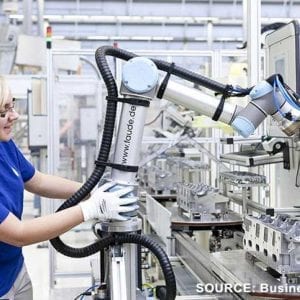
View original at www.therobotreport.com
There is growing demand for more flexibility in factories and shops. Collaborative robotics, a sub-set of service robotics in labs, manufacturing and material handling, is where the action is today because co-bots are meeting these new demands, while caged legacy robots are not. Service and assistance robotics, with and without mobility, are an emerging and somewhat futuristic field, albeit one which is developing rapidly. Vision and tactile sensors, safety features, mobility, and simple, fast and intuitive robot training, are all playing important roles in many application areas. As robots can be trusted to safely work alongside humans and are relatively portable and easy to program, business managers, from all sized companies, begin to imagine uses within their labs, facilities, factories and shops – uses where robots and humans collaboratively work together to improve productivity and efficiency by using the robot where it is better than its human partners, and vice versa. Definitions, features and applications The objective of collaborative robotics is to combine the repetitive performance of robots with the individual skills and abilities of people. People are better at seeing and solving imprecise situations; robots can be more precise, powerful, and perform longer. Wikipedia says a cobot or co-robot (from collaborative robot) is a robot intended to physically interact with humans in a shared workspace. This is in contrast with other robots, designed to operate autonomously or with limited guidance, which is what most industrial robots do. Cobots can have many roles — from autonomous robots capable of working together with humans in an office setting that can ask for help, to industrial robots having their protective guards removed as they can react to a human presence under EN ISO 10218 which requires the robot or robot application comply with one of four collaborative modes: Safety-Rated Monitored Stop; […]



Leave a Reply
You must be logged in to post a comment.